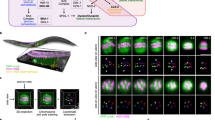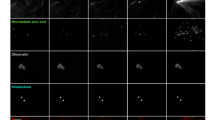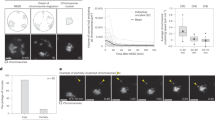Abstract
Although centrosomes serve to organize microtubules in most cell types, oocyte spindles form and mediate meiotic chromosome segregation in their absence. Here, we used high-resolution imaging of both bipolar and experimentally generated monopolar spindles in Caenorhabditis elegans to reveal a surprising organization of microtubules and chromosomes within acentrosomal structures. We found that homologous chromosome pairs (bivalents) are surrounded by microtubule bundles running along their sides, whereas microtubule density is extremely low at chromosome ends despite a high concentration of kinetochore proteins at those regions. Furthermore, we found that the chromokinesin KLP-19 (kinesin-like protein 19) is targeted to a ring around the centre of each bivalent and provides a polar ejection force that is required for congression. Together, these observations create a new picture of chromosome–microtubule association in acentrosomal spindles and reveal a mechanism by which metaphase alignment can be achieved using this organization. Specifically, we propose that ensheathment by lateral microtubule bundles places spatial constraints on the chromosomes, thereby promoting biorientation, and that localized motors mediate movement along these bundles, thereby promoting alignment.
This is a preview of subscription content, access via your institution
Access options
Subscribe to this journal
Receive 12 print issues and online access
$209.00 per year
only $17.42 per issue
Buy this article
- Purchase on Springer Link
- Instant access to full article PDF
Prices may be subject to local taxes which are calculated during checkout





Similar content being viewed by others
References
Walczak, C. E. & Heald, R. Mechanisms of mitotic spindle assembly and function. Int. Rev. Cytol. 265, 111–158 (2008).
Kapoor, T. M., Mayer, T. U., Coughlin, M. L. & Mitchison, T. J. Probing spindle assembly mechanisms with monastrol, a small molecule inhibitor of the mitotic kinesin, Eg5. J. Cell Biol. 150, 975–988 (2000).
Canman, J. C. et al. Determining the position of the cell division plane. Nature 424, 1074–1078 (2003).
Lampson, M. A., Renduchitala, K., Khodjakov, A. & Kapoor, T. M. Correcting improper chromosome-spindle attachments during cell division. Nature Cell Biol. 6, 232–237 (2004).
Segbert, C. et al. KLP-18, a Klp2 kinesin, is required for assembly of acentrosomal meiotic spindles in Caenorhabditis elegans. Mol. Biol. Cell 14, 4458–4469 (2003).
Albertson, D. G. & Thomson, J. N. Segregation of holocentric chromosomes at meiosis in the nematode, Caenorhabditis elegans. Chromosome Res. 1, 15–26 (1993).
Howe, M., McDonald, K. L., Albertson, D. G. & Meyer, B. J. HIM-10 is required for kinetochore structure and function on Caenorhabditis elegans holocentric chromosomes. J. Cell Biol. 153, 1227–1238 (2001).
Monen, J., Maddox, P. S., Hyndman, F., Oegema, K. & Desai, A. Differential role of CENP-A in the segregation of holocentric C. elegans chromosomes during meiosis and mitosis. Nature Cell Biol. 7, 1248–1255 (2005).
Mazumdar, M. & Misteli, T. Chromokinesins: multitalented players in mitosis. Trends Cell Biol. 15, 349–355 (2005).
Powers, J. et al. Loss of KLP-19 polar ejection force causes misorientation and missegregation of holocentric chromosomes. J. Cell Biol. 166, 991–1001 (2004).
Schumacher, J. M., Golden, A. & Donovan, P. J. AIR-2: An Aurora/Ipl1-related protein kinase associated with chromosomes and midbody microtubules is required for polar body extrusion and cytokinesis in Caenorhabditis elegans embryos. J. Cell Biol. 143, 1635–1646 (1998).
Speliotes, E. K., Uren, A., Vaux, D. & Horvitz, H. R. The survivin-like C. elegans BIR-1 protein acts with the Aurora-like kinase AIR-2 to affect chromosomes and the spindle midzone. Mol. Cell 6, 211–223 (2000).
Rogers, E., Bishop, J. D., Waddle, J. A., Schumacher, J. M. & Lin, R. The aurora kinase AIR-2 functions in the release of chromosome cohesion in Caenorhabditis elegans meiosis. J. Cell Biol. 157, 219–229 (2002).
Kaitna, S., Pasierbek, P., Jantsch, M., Loidl, J. & Glotzer, M. The aurora B kinase AIR-2 regulates kinetochores during mitosis and is required for separation of homologous Chromosomes during meiosis. Curr. Biol. 12, 798–812 (2002).
Romano, A. et al. CSC-1: a subunit of the Aurora B kinase complex that binds to the survivin-like protein BIR-1 and the incenp-like protein ICP-1. J. Cell Biol. 161, 229–236 (2003).
Kaitna, S., Mendoza, M., Jantsch-Plunger, V. & Glotzer, M. Incenp and an aurora-like kinase form a complex essential for chromosome segregation and efficient completion of cytokinesis. Curr. Biol. 10, 1172–1181 (2000).
Tanaka, K. et al. Molecular mechanisms of kinetochore capture by spindle microtubules. Nature 434, 987–994 (2005).
Rieder, C. L. & Alexander, S. P. Kinetochores are transported poleward along a single astral microtubule during chromosome attachment to the spindle in newt lung cells. J. Cell Biol. 110, 81–95 (1990).
Hayden, J. H., Bowser, S. S. & Rieder, C. L. Kinetochores capture astral microtubules during chromosome attachment to the mitotic spindle: direct visualization in live newt lung cells. J. Cell Biol. 111, 1039–1045 (1990).
Merdes, A. & De Mey, J. The mechanism of kinetochore-spindle attachment and polewards movement analyzed in PtK2 cells at the prophase-prometaphase transition. Eur. J. Cell Biol. 53, 313–325 (1990).
Kapoor, T. M. et al. Chromosomes can congress to the metaphase plate before biorientation. Science 311, 388–391 (2006).
Skold, H. N., Komma, D. J. & Endow, S. A. Assembly pathway of the anastral Drosophila oocyte meiosis I spindle. J. Cell Sci. 118, 1745–1755 (2005).
Cullen, C. F., Brittle, A. L., Ito, T. & Ohkura, H. The conserved kinase NHK-1 is essential for mitotic progression and unifying acentrosomal meiotic spindles in Drosophila melanogaster. J. Cell Biol. 171, 593–602 (2005).
Jang, J. K., Rahman, T. & McKim, K. S. The kinesinlike protein Subito contributes to central spindle assembly and organization of the meiotic spindle in Drosophila oocytes. Mol. Biol. Cell 16, 4684–4694 (2005).
Jang, J. K., Rahman, T., Kober, V. S., Cesario, J. & McKim, K. S. Misregulation of the kinesin-like protein Subito induces meiotic spindle formation in the absence of chromosomes and centrosomes. Genetics 177, 267–280 (2007).
Brunet, S. et al. Kinetochore fibers are not involved in the formation of the first meiotic spindle in mouse oocytes, but control the exit from the first meiotic M phase. J. Cell Biol. 146, 1–12 (1999).
Schuh, M. & Ellenberg, J. Self-organization of MTOCs replaces centrosome function during acentrosomal spindle assembly in live mouse oocytes. Cell 130, 484–498 (2007).
Boleti, H., Karsenti, E. & Vernos, I. Xklp2, a novel Xenopus centrosomal kinesin-like protein required for centrosome separation during mitosis. Cell 84, 49–59 (1996).
Walczak, C. E., Vernos, I., Mitchison, T. J., Karsenti, E. & Heald, R. A model for the proposed roles of different microtubule-based motor proteins in establishing spindle bipolarity. Curr. Biol. 8, 903–913 (1998).
Wittmann, T., Wilm, M., Karsenti, E. & Vernos, I. TPX2, A novel Xenopus MAP involved in spindle pole organization. J. Cell Biol. 149, 1405–1418 (2000).
Kashina, A. S., Rogers, G. C. & Scholey, J. M. The bimC family of kinesins: essential bipolar mitotic motors driving centrosome separation. Biochim. Biophys. Acta 1357, 257–271 (1997).
Mitchison, T. J. et al. Roles of polymerization dynamics, opposed motors, and a tensile element in governing the length of Xenopus extract meiotic spindles. Mol. Biol. Cell 16, 3064–3076 (2005).
Yang, G. et al. Architectural dynamics of the meiotic spindle revealed by single-fluorophore imaging. Nature Cell Biol. 9, 1233–1242 (2007).
Bishop, J. D., Han, Z. & Schumacher, J. M. The Caenorhabditis elegans Aurora B kinase AIR-2 phosphorylates and is required for the localization of a BimC kinesin to meiotic and mitotic spindles. Mol. Biol. Cell 16, 742–756 (2005).
McNally, K., Audhya, A., Oegema, K. & McNally, F. J. Katanin controls mitotic and meiotic spindle length. J. Cell Biol. 175, 881–891 (2006).
Fraser, A. G. et al. Functional genomic analysis of C. elegans chromosome I by systematic RNA interference. Nature 408, 325–330 (2000).
Kamath, R. S. et al. Systematic functional analysis of the Caenorhabditis elegans genome using RNAi. Nature 421, 231–237 (2003).
Oegema, K., Desai, A., Rybina, S., Kirkham, M. & Hyman, A. A. Functional analysis of kinetochore assembly in Caenorhabditis elegans. J. Cell Biol. 153, 1209–1226 (2001).
Cheeseman, I. M. et al. A conserved protein network controls assembly of the outer kinetochore and its ability to sustain tension. Genes Dev. 18, 2255–2268 (2004).
McCarter, J., Bartlett, B., Dang, T. & Schedl, T. On the control of oocyte meiotic maturation and ovulation in Caenorhabditis elegans. Dev. Biol. 205, 111–128 (1999).
Acknowledgements
We thank members of the Villeneuve laboratory for support and discussions, R. Heald, V. Indjeian and M. Schvarzstein for comments on the manuscript, J. Monen, P. Maddox and members of the Desai and Oegema laboratories for technical advice, J. Dumont and A. Desai for sharing data before publication, and J. Audhya, B. Bowerman, A. Desai, B. Meyer, J. Powers and J. Schumacher for reagents. Additionally, some strains used in this work were provided by the Caenorhabditis Genetics Center, which is funded by the NIH National Center for Research Resources (NCRR). This work was supported by an NIH grant (RO1 GM53804) to A.M.V.; S.M.W. was a Damon Runyon Fellow supported by the Damon Runyon Cancer Research Foundation (DRG-#1827-04) and is currently a Special Fellow of the Leukemia and Lymphoma Society.
Author information
Authors and Affiliations
Contributions
All experimental data and figures were generated by S.M.W., who also had primary responsibility for experimental design, data analysis and manuscript writing. A.M.V. contributed to experimental design, data analysis and manuscript writing.
Corresponding authors
Ethics declarations
Competing interests
The authors declare no competing financial interests.
Supplementary information
Supplementary Information
Supplementary Information (PDF 819 kb)
Supplementary Information
Supplementary Movie 1 (MOV 1123 kb)
Supplementary Information
Supplementary Movie 2 (MOV 471 kb)
Rights and permissions
About this article
Cite this article
Wignall, S., Villeneuve, A. Lateral microtubule bundles promote chromosome alignment during acentrosomal oocyte meiosis. Nat Cell Biol 11, 839–844 (2009). https://doi.org/10.1038/ncb1891
Received:
Accepted:
Published:
Issue Date:
DOI: https://doi.org/10.1038/ncb1891
This article is cited by
-
Phosphorylation of adducin-1 by TPX2 promotes interpolar microtubule homeostasis and precise chromosome segregation in mouse oocytes
Cell & Bioscience (2022)
-
Mechanisms driving acentric chromosome transmission
Chromosome Research (2020)
-
Ultrastructural analysis of mitotic Drosophila S2 cells identifies distinctive microtubule and intracellular membrane behaviors
BMC Biology (2018)
-
Non-Mendelian assortment of homologous autosomes of different sizes in males is the ancestral state in the Caenorhabditis lineage
Scientific Reports (2017)
-
Chromosome segregation occurs by microtubule pushing in oocytes
Nature Communications (2017)



